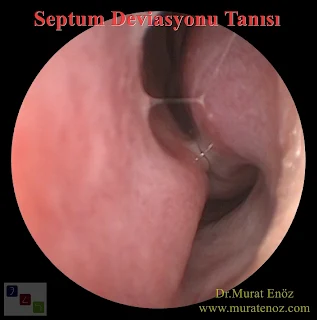Diagnosis of Deviated Nasal Septum
 |
| Tomography is Not Always Required for the Diagnosis of Nasal Septum Deviation! |
CT scans use X-rays to generate images of computerized two- and three-dimensional bone, cartilage, and other nasal structures. This allows doctors to examine the nose from various angles. Normally, a simple ENT examination and anterior rhinoscopic examination is sufficient for deviation of the nasal septum. In patients with private insurance, if the policy conditions cover the deviation of the septum, it is generally desirable to have a CT scan prior to surgery to document the disease. In chronic sinusitis or endoscopic examination, CT scan is appropriate in patients with treatment-resistant chronic sinusitis in the presence of severe septum deviation, nasal polyps or masses, which prevents complete evaluation of the nasal cavity. Tomography is preferred in patients with facial injuries and traumatic nasal fractures.
It is recommended that patients with complaints of constant nasal congestion (feeling of insufficiency of breathing through the nose, the need to breathe through the mouth) during fast walking or in sporting activities in normal daily life, and patients with complaints of open mouth sleep should be examined by an ENT specialist. Septum deviation may be present at birth, may be curved during growth, or may result from injury to the nose and face.
To examine the interior of the nose, a bright light and sometimes a device designed to open the nostrils (nose speculum) or a long and thin tubular endoscope with a bright light at the end can be used. The diagnosis of nasal septum deviation can be made in this way during a simple nose examination. During the examination, sometimes a decongestant spray can be applied to the nose before and after the examination. Some septum deviations are deep in the nasal cavity and may require more evaluation than endoscopic examination in office conditions. Paranasal sinus computed tomography is generally required as imaging method. Deviation of the nasal septum is usually not necessary for the diagnosis.
What is Acoustic Rhinometry?
Acoustic rhinometry (AR) evaluates the nasal patency based on measuring acoustic reflection of the sound signal in the nasal cavity with structures in the nasal cavity. The AR analyzes the first and reflected sound waves so that the cross-sectional area of the nasal cavity forms an area as a function of the distance from the nasal cavity entry.Rhinomanometry provides a dynamic physiological assessment of the nose by measuring transnasal pressure and nasal volume airflow to calculate nasal resistance. Nasal sound spectrum analysis (NSSA) provides an indirect method of dynamically evaluating nasal air flow by analyzing the noise caused by the variable nasal air flow in the nasal cavity.
Further diagnostic methods, such as acoustic rhinometry, rhinomanometry, and nasal spectral sound analysis, may be useful in identifying deviation of the nasal septum in the anterior region of the nasal cavity, but use of these tests is limited. Compared with anterior rhinoscopy, nasal endoscopy, and imaging, these advanced diagnostic procedures lack sensitivity and specificity in determining the location and severity of nasal septum deviation.
Nasal Septum Deviation in Children
 |
| Diagnosis of Nasal Septum Deviation |
How do you know if your nose has a septum deviation?
Deviation of the nasal septum is in fact more or less severe in many people (found in about 80 of 100 people). Most people with nasal septum deviation do not have much symptoms or complaints. If the amount of deviation of the septum in your nose is excessive, or if it is a curvature close to the narrowest area of the nose, the nasal valve, it may cause the following symptoms:. nasal congestion
. open mouth sleep and decrease in sleep quality
. headache
. sensation of insufficiency of breathing through the nose during exercise or decreased mobility capacity
. feeling of dryness in the throat
. increased incidence of gum diseases or bad breath
. Increased attacks of chronic pharyngitis
. postnasal drip
. nose bleeding
. need to lie on the side of sleep deviation
In fact, these symptoms may vary depending on the deviation and the amount of curvature. If you have any of these complaints, it is sufficient to consult an ENT specialist.
Similar links >> Nasal Septum Deviation - Symptoms, Diagnosis and Treatment / Septoplasty in Istanbul / Open Technique Nasal Septum Correction Surgery
Source links >>
Source links >>
- Deviated septum - Diagnosis and treatment - Mayo Clinic
- What Is Deviated Septum? Surgery, Symptoms, Recovery, & Causes
- Measurement tools for the diagnosis of nasal septal deviation: a ...
- Deviated nasal septum. Incidence and etiology
- Dislocation of the nasal septal cartilage in the newborn
- Septal deviation in newborn infants / How septum deformations in newborns occur
Murat Enoz, MD, Otorhinolaryngology, Head and Neck Surgeon - ENT Doctor in Istanbul
Private Office:
Address: İncirli Cad. No:41, Kat:4 (Dilek Patisserie Building), Postal code: 34147, Bakırköy - İstanbul
Appointment Phone: +90 212 561 00 52
Appointment Phone: +90 212 561 00 52
Fax: +90 212 542 74 47

Comments
Post a Comment